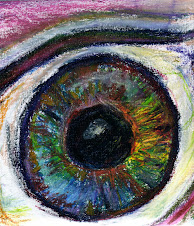Wednesday, November 26, 2008
Why do some people move their heads back and forth when they are reading?
If you have to move your head to follow the text when you read your ocular motilities may be deficient. When the six eye muscles in each eye move efficiently in coordination with each other, they can make very fine eye movements. The muscles coordinate to point the eyeballs to keep a visual image near and single. People who use their neck muscles to point their eyes don't realize this- it isn't a conscious failure, though. These people may have deficits of their saccadic eye movements, the short little hops that the eyes make from the end of one word or line of text to the beginning of the next. These same individuals may find it helpful to use a straight edge to keep their place while reading. They may also experience frequent loses of place and may habitually skip little words or even whole lines of text. Developmental optometrists often incorporate vision therapy in their practices. Simple activities and exercises can often promote the development of great saccadic eye movements over a period of several weeks.
Tuesday, November 18, 2008
Can a vision problem make reading seem too hard?
Children who are unable to team their eyes efficiently on a near-point visual target may have a condition called Convergence Insufficiency (CI). These children may complain that reading is too hard or that it is boring or that it gives them a headache. They may also complain that words double on the page or wiggle. Recently the results of a randomized clinical trial of treatments for symptomatic convergence insufficiency in children was published in the Archives of Ophthalmology (vol. 126 No. 10, October 2008). The study found that this condition can be successfully treated through in-office vision therapy. You can read the full study online at http://archopht.ama-assn.org/cgi/content/full/126/10/1336. CI is not the only learning-related visual issue that can interfere with a child's reading performance. If your child is having difficulty with school, arrange for a binocular vision examination by developmental optometrist who will be able help if there are any contributory visual issues. To find a developmental optometrist in your area go to www.covd.org and search for members of the College of Optometrists in Vision Development near you. The American Optometric Association recommends that every child receive an annual eye exam. It's important.
Friday, November 14, 2008
What's So Important About How A Student Holds A Pencil?
Many of the patients that I see in my work as an optometric vision therapist do not have good pencil posture. Instead of the relaxed, efficient grip that should be required of each kindergarten student who is learning to write, many students who struggle with learning related vision problems use a fist grip or hold the pencil very close to the tip or do not secure the paper with their free hand. The issue is not limited to poor or illegible handwriting. In an article in the OEP Vision Therapist, Volume 33, Number 1, 1991, therapist Denis Hoover reported on the observations of Dr. Ernest J. Kahn. This optometrist administered the Sentence Copy test (probably by Wold) to his patients and noticed the following three associations.
- Most near-sighted children hold their pencil 1/4 inch or closer to the tip.
- Most children who also have been diagnosed with a learning disability utilize "bizarre" pencil grips and also exhibit poor coordination in general.
- All the children who used nonstandard pencil postures blocked their line of sight with their fingers so they had to adopt an improper reading distance or head tilt.
So, if your student or child does not use a standard pencil grip, first try to retrain the skill. Many teacher supply stores carry soft grip guides that help a child remember where to hold the pencil. These are inexpensive and very helpful. Then, because this behavior may indicate that the child may be struggling with a learning-related visual challenge or may even need glasses, make sure to schedule a routine eye examination with a developmental optometrist who is experienced in working with children.
Subscribe to:
Comments (Atom)




